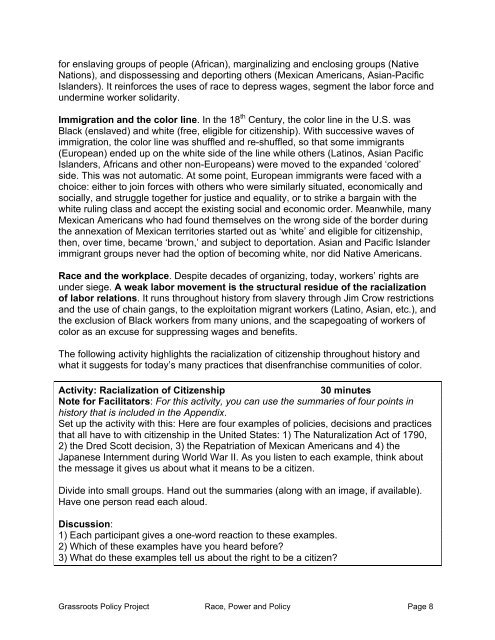Institutional Racism
Institutional Racism
Institutional Racism
Create successful ePaper yourself
Turn your PDF publications into a flip-book with our unique Google optimized e-Paper software.
for enslaving groups of people (African), marginalizing and enclosing groups (Native<br />
Nations), and dispossessing and deporting others (Mexican Americans, Asian-Pacific<br />
Islanders). It reinforces the uses of race to depress wages, segment the labor force and<br />
undermine worker solidarity.<br />
Immigration and the color line. In the 18 th Century, the color line in the U.S. was<br />
Black (enslaved) and white (free, eligible for citizenship). With successive waves of<br />
immigration, the color line was shuffled and re-shuffled, so that some immigrants<br />
(European) ended up on the white side of the line while others (Latinos, Asian Pacific<br />
Islanders, Africans and other non-Europeans) were moved to the expanded ‘colored’<br />
side. This was not automatic. At some point, European immigrants were faced with a<br />
choice: either to join forces with others who were similarly situated, economically and<br />
socially, and struggle together for justice and equality, or to strike a bargain with the<br />
white ruling class and accept the existing social and economic order. Meanwhile, many<br />
Mexican Americans who had found themselves on the wrong side of the border during<br />
the annexation of Mexican territories started out as ‘white’ and eligible for citizenship,<br />
then, over time, became ‘brown,’ and subject to deportation. Asian and Pacific Islander<br />
immigrant groups never had the option of becoming white, nor did Native Americans.<br />
Race and the workplace. Despite decades of organizing, today, workers’ rights are<br />
under siege. A weak labor movement is the structural residue of the racialization<br />
of labor relations. It runs throughout history from slavery through Jim Crow restrictions<br />
and the use of chain gangs, to the exploitation migrant workers (Latino, Asian, etc.), and<br />
the exclusion of Black workers from many unions, and the scapegoating of workers of<br />
color as an excuse for suppressing wages and benefits.<br />
The following activity highlights the racialization of citizenship throughout history and<br />
what it suggests for today’s many practices that disenfranchise communities of color.<br />
Activity: Racialization of Citizenship<br />
30 minutes<br />
Note for Facilitators: For this activity, you can use the summaries of four points in<br />
history that is included in the Appendix.<br />
Set up the activity with this: Here are four examples of policies, decisions and practices<br />
that all have to with citizenship in the United States: 1) The Naturalization Act of 1790,<br />
2) the Dred Scott decision, 3) the Repatriation of Mexican Americans and 4) the<br />
Japanese Internment during World War II. As you listen to each example, think about<br />
the message it gives us about what it means to be a citizen.<br />
Divide into small groups. Hand out the summaries (along with an image, if available).<br />
Have one person read each aloud.<br />
Discussion:<br />
1) Each participant gives a one-word reaction to these examples.<br />
2) Which of these examples have you heard before?<br />
3) What do these examples tell us about the right to be a citizen?<br />
Grassroots Policy Project Race, Power and Policy Page 8

















